Breather Systems
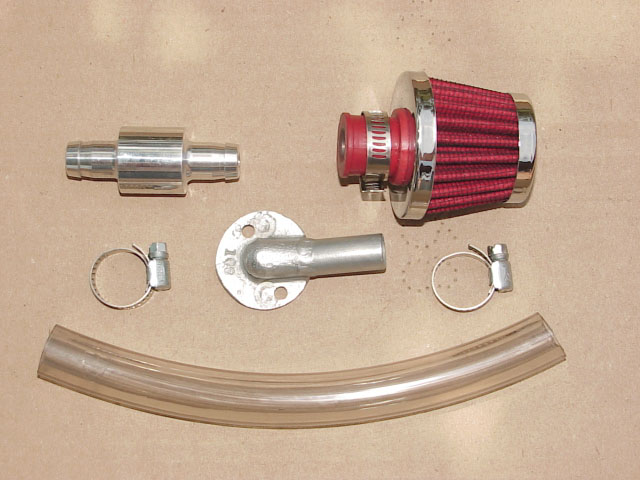
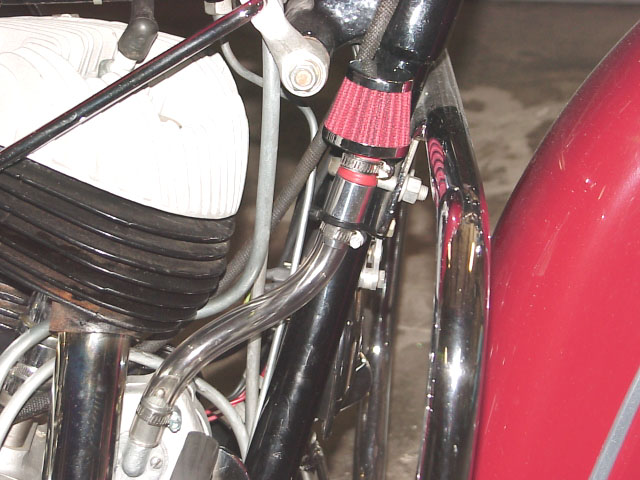
Engine breather systems are a very important part of any performance motor. They are often mis-understood, and usually neglected. A performance motor benefits from proper breathing more so than a slow running stock motor, because at higher RPM, a motor slings more oil into the cavities of the crankcase at a higher rate, and with more energy. The act of oil mixing with air, by rapid spinning rods, and flywheels is called "windage". It has always been addressed by car racers, especially those used in hard cornering, or in drag racing take-offs. Windage causes a loss in power due to the drag of oil being hit by rotating components. It also heats the oil, and eventually breaks down the quality of the oil. In our Indian V-twins, when the crankcase oil is mixed with air, it is easily carried out the breather line, and it usually ends up covering the rear of the motorcycle. This becomes a nuisance, and an un-necessary loss of oil (not to mention the saftey concern of this oil finding it's way onto the rear tire!). While the crank shaft is spinning, the pistons are rising, and falling at varying rates based on RPM. This action quickly pressurizes the crankcase with compressed air in a volume equal to the displacement of the cylinders. When the pistons rise, the crankcase is being relieved of pressure by the suction from the pistons rising. This action is quick acting, and happens the full time that the motor is rotating.
It actually takes quite a bit of power for the pistons to push air out of a breather port while the pistons are going down. The same can be said for the up stroke of the pistons. Think of the crankcase space, and the pistons as a compressor. It takes alot of power to drive a compressor, and our motors are doing the same thing. On a down stroke, it is moving air outward, then it has to work to bring the air back in (assuming that there is no form of a one-way check valve). It is a hard concept to understand, but an open breather line costs more power than a closed one. Think about compression release mechanisms on motors, or Deisel "engine brakes". Once a passageway has been opened to the combustion chambers, while the motor is running, the motor will quickly slow in RPM. I had a long wing "self-launching" racing sailplane with a Rotax 2-cylinder, 2-stroke motor. When it was time to shut off the motor, and stow it, the propeller needed to be slowed all the way down before engaging a catch to position it up and down before stowing it in the fuselage. I could kill the ignition, but the propeller would spin, and keep spinning from the on-rushing wind. It wouldn't even begin to slow until I pulled out the decompression valve, which was opening up a hole in the head the size of a spark plug hole. It allowed air to be pumped into the top end, and pushed out rapidly just like the crankcase does in normal operation. Pulling this decompression valve open would quickly slow the fast spinning propeller to a stop in about 4 revolutions. This showed me that it must take alot of power to pump air in, as well as out of a motor.
There are a few different ways that motorcycle manufacturers have tried to handle engine crankcase breathing. Harley-Davidsons, and Vincent twins use a timed breather that is a rotating valve driven by the cams, which only lets crankcase pressure out during the piston's down stroke. It closes off at the beginning of the piston's up stroke to make the crankcase area go slightly towards a vacuum. The timed breathers worked fairly well, but didn't close off well enough to get the maximum crankcase vacuum possible. Indians used a flapper disc that would freely open, and close depending on the direction of the air being pumped. They were slightly efficient, and too small in size (restrictive).
Meanwhile, most European bikes simply use a breather port that has no form of check valve, and the crankcase air is pumped in, and out of the oil tank, while the oil tank has a seperate breather port out to atmosphere.
Since my interests run mostly with Indian V-twins, my further explanations here will be based on applying a proper breathing system to an Indian V-twin, whether Chiefs, or Scouts (even though the theory applys to all motorcycle motors). My thought was to find a way to get the most air to move out of the crankcase that I could by opening up the passageways for air to breath. On Chiefs, I have modified the breather port on the cam cover by eliminating the factory flapper disc, and removing the small copper breather tube. Then I modified the breather tube casting with a larger 1/2" thin walled tube pointing upward, so oil mist carrying air would go upward in a larger, free breathing 1/2" ID clear Tygon tube for a length of 7" before entering a free flowing, and fast acting check valve. My thought was that this oil mist air would rise, and collect on the walls of the clear tubing, and gravity would pull it back down into the cam chest. No oil would be leaving the breather tube, and getting all over the bike! I searched for an effective breather check valve, and I found the "Krank-Vent" manufactured by ET Performance in Santa Barbara, California. There are similar check valves available, but I like the Krank-Vent, because of it's small size, and high quality. They offer one with two 3/8" hose barbs, but I prefer their other one that uses 1/2" hose barbs. Internally, they are both the same, and flow the same volume of air, but the 1/2" version allows larger ID tubing to be used, which slows the velocity of the moving air. A stock Chief, or Scout has to breath through small ID tubing, which while being very restrictive, only allows a portion of the available air to move out. The air is also moving at higher velocity, which shoots oil out of the tube. Plus, the factory style copper tube goes downward, so that any oil entering the tube WILL leave the motor. On a Chief, the Krank-Vent check valve ends up next to the right side of the shifter tube on the frame. I add a small K&N style breather filter to the Krank-Vent's exit side. Another option is to run some more 1/2" ID Tygon tubing to the Krank-Vent exit, and to extend it under the fuel tank, and run it down under the transmission to atmosphere. The extra tubing moved under the bike aids in quieting the popping sound that is made from the Krank-Vent working.
Scouts breath differently than a Chief. A Chief breathes out of the front of the cam cover, while a Scout breathes from the cam chest into a void in the oil pump, then out of the pump by way of a threaded port on the top rear of the oil pump. Scouts place their little factory flapper disc under the pump before it is installed. When adding a Krank-Vent, you will omit the flapper disc. In order to increase the ability to move more air, I like to add a second breathing port on Scout cases. There is a small flat area on the right side engine case directly behind where the distributor mounts. It is located above the rotating cams, and is a good source of moving air. I drill, and tap a 1/8" NPT hole, so I can add a free breathing straight steel hose fitting for 3/8" hose. I cut off the 3/8" hose barb end, and weld on a 1" length of thin walled 1/2" OD steel tubing. I also add a free breathing 45 degree 3/8" hose fitting to the factory breather port on the oil pump. Now, I make a free breathing "Y" manifold that joins these two breather ports, and the "Y" manifold rises straight up, then curves 90 degrees over the top of the intake manifold. I install the Krank-Vent to the "Y" manifold above the intake manifold, with the exit pointing to the left side of the bike. Now, I attach some 1/2" Tygon clear tube, and run it down-hill to an oil catch can mounted behind, and below the carb. I make a catch can that is chambered, so that oil mist can collect at the bottom of the catch can, while allowing the air to escape through a K&N type breather filter at the top of the catch can. I decided that I wanted a re-circulating oil breather system, so I installed a small drain hole from the bottom of the catch can running down-hill to my sump scraper. My idea was that while the Krank-Vent was putting the crankcase in a vacuum state, this vacuum would assist in sucking any oil from the catch can back into the motor. This requires that the return line be very small, like the size of a normal oil tank vent line, and it must run down hill at all times. Plus, the right side engine case must be modified to use a 1947 style Chief sump "scraper". I drill, and tap another 1/8" NPT hole in the side of the scraper to accept a fitting for mounting the catch can return line. Whenever using a proper check valve like the Krank-Vent, the motor needs to be completely sealed everywhere that might let air to sneak into the crankcase. It must only breath through a port that the Krank-Vent is attached to, in order to get the crankcase in the highest vacuum state!
A catch can is not necessary! You can just run a tube from the Krank-Vent exit back, and down to a hidden space, and let it vent out to atmosphere.
The greater the crankcase vacuum, the greater the benefit. The pistons don't have to work as hard moving air in, and out of the motor, so there is an actual gain in power. The rings will be drawn tighter against their ring land, preventing a degree of "ring flutter". This better ring seal will reduce the amount of normal blowby gasses entering the crankcase, which results in cleaner oil. The better ring seal, also reduces the amount of oil entering the combustion chamber, which is also destructive, and wasteful. More power, a cleaner bike, cleaner oil, and less oil consumption are all good things. I use this system on my Twin-Scout Land Speed record holder, and my motors are always sparkling clean, even after running it at high RPM for sustained periods. Plus, I'm happy to enjoy the other benefits of more power, and a cleaner combustion chamber. This system has proven to be very effective.
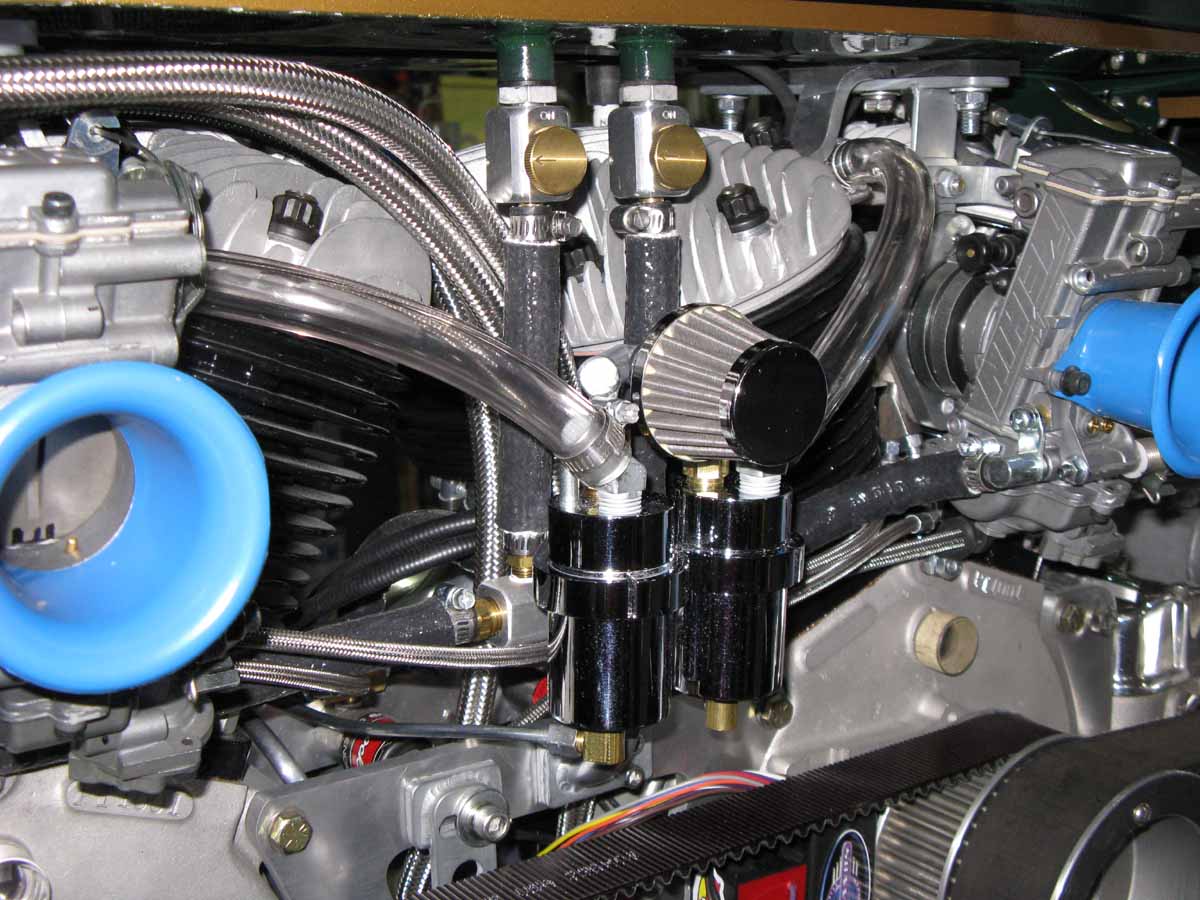
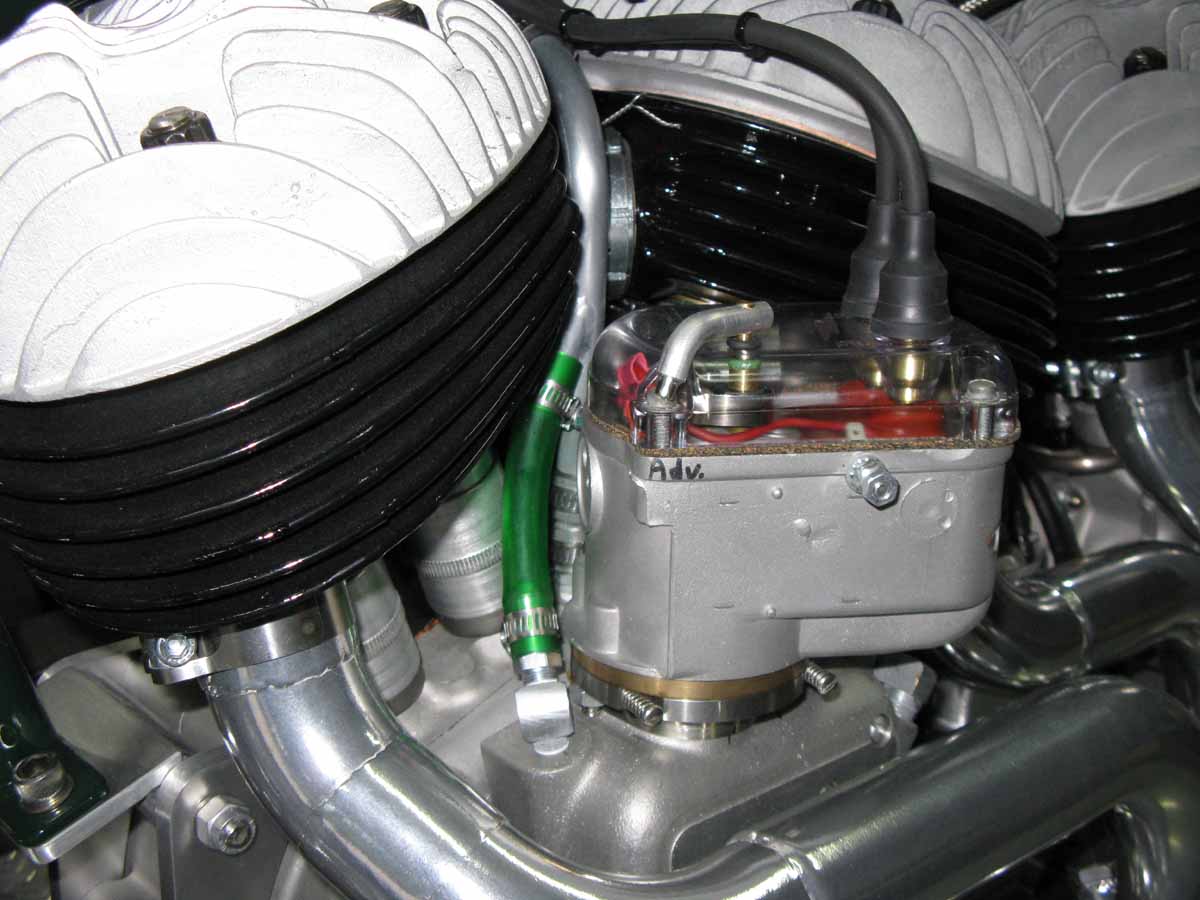
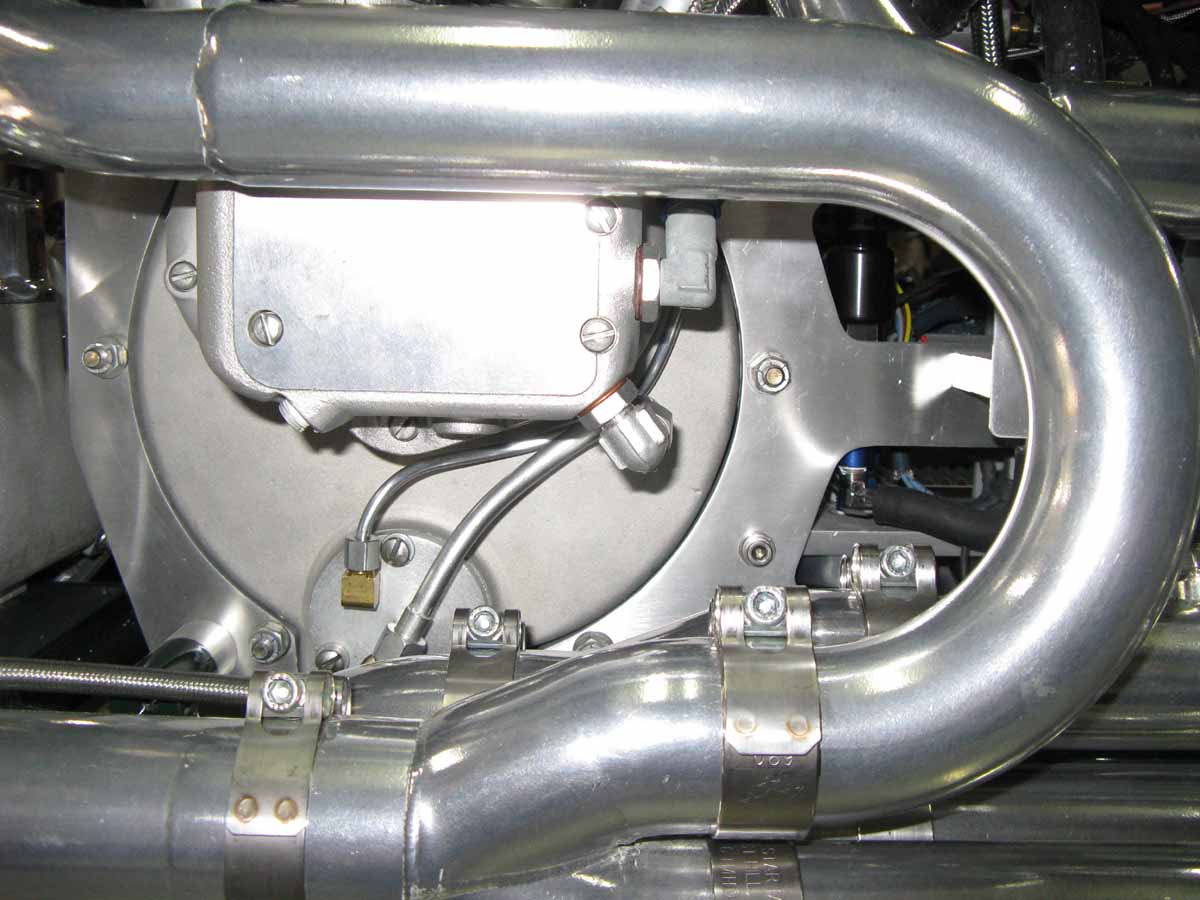
CONTACT INFORMATION:
James R. Mosher
(505) 466-7870






